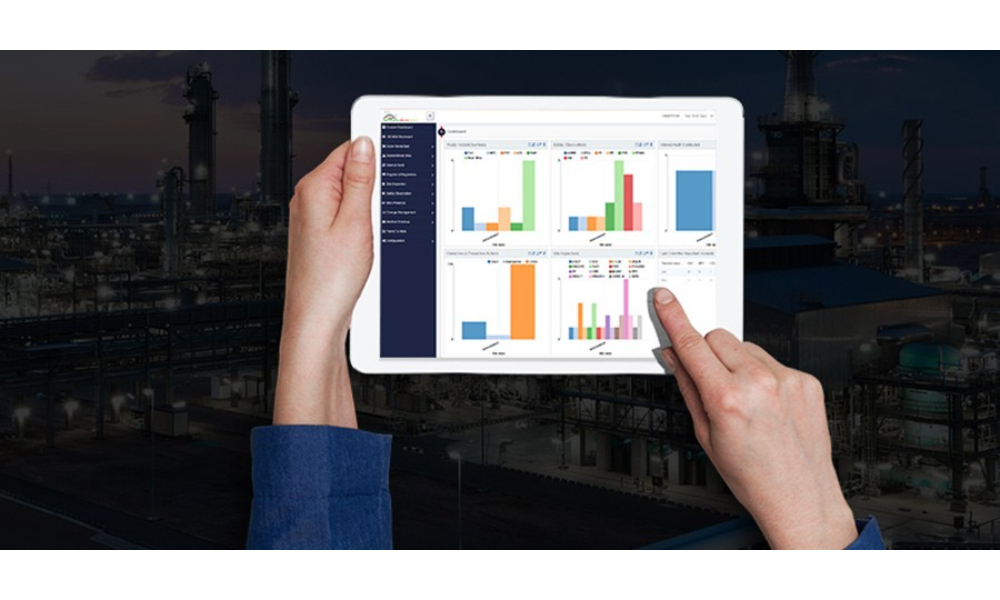EHS compliance software enables businesses to manage risks effectively while ensuring adherence to regulatory requirements. It provides greater visibility into potential hazards and equips companies with the tools to implement corrective measures.
Although the concept of health and safety management software may seem straightforward, most solutions on the market include multiple modules designed to support a wide range of functions. These may include incident tracking, audits and inspections, risk assessment and mitigation, real-time data analysis, and compliance management, among others.
Here are five key features to look for in EHS software and how to leverage them for your business.
1. A Solution That Supports Every Step of Your Health and Compliance Journey
Ensuring compliance with environmental, health, and safety regulations is a complex and ongoing process. Every organization has unique requirements and industry-specific standards that must be met. EHS compliance software plays a crucial role in simplifying this process, helping businesses effectively navigate the challenges of health and safety regulations.
Whether an organization chooses to manage compliance internally or engage external experts, the right software should offer flexibility in designing customized forms and workflows tailored to specific operational needs. A well-designed system should be intuitive, allowing for seamless configuration without requiring advanced coding skills or technical expertise.
Beyond ease of use, automation is a key factor in enhancing efficiency. The software should be capable of streamlining manual and repetitive tasks, ensuring that necessary follow-ups and approvals are carried out consistently and without unnecessary delays.
Integration with existing systems is another vital feature, allowing businesses to consolidate data from various platforms and transform raw information into actionable insights. Real-time analytics enable organizations to monitor compliance efforts and make informed decisions based on current data.
Moreover, the software should foster a culture of accountability and engagement by keeping employees well-informed through cloud-based accessibility. By providing instant updates and facilitating communication across teams, businesses can establish a proactive approach to health and safety compliance, ultimately strengthening their overall operational framework.
2. Real-Time Data Capabilities for Enhanced Decision-Making
Access to real-time data has revolutionized various industries, driving improvements in areas such as patient care, customer experience, and public health initiatives. Its ability to support rapid decision-making and adaptability makes it an essential component of effective environmental, health, and safety management.
With a web-enabled device, team members should be able to complete daily tasks, update records, and interact with the software from any location. This accessibility ensures that critical compliance activities are not restricted by physical boundaries, allowing operations to continue seamlessly regardless of where employees are working.
In the field of health and safety, timely responses are essential. Urgent matters require immediate attention, and delays in accessing information can impact compliance efforts. A robust software solution should ensure that data collected in the field is instantly available to relevant personnel, eliminating the need to wait hours or even days for crucial information to be processed.
For employees who are frequently on the move, the system should offer instant alerts that direct users to the necessary documents or data, facilitating swift actions in ongoing workflows and investigations. This real-time responsiveness minimizes downtime and ensures that compliance measures are promptly addressed.
Additionally, all submitted data should be compiled into analytical and comparative reports with drill-down functionalities, allowing businesses to assess performance metrics in greater detail. This in-depth analysis supports continuous improvement initiatives and enhances compliance strategies.
By minimizing the time required to relay critical information to decision-makers, organizations can improve their responsiveness and overall efficiency. The ability to access and act on real-time data empowers businesses to make more informed choices, optimize workflows, and strengthen their compliance framework, ultimately leading to better operational outcomes.

3. Automated Measures for Proactively Managing Workplace Risks and Hazards
The latest advancements in software technology indicate that automation is set to have a significant impact on the market. Predictions suggest that a substantial number of knowledge-based roles will increasingly rely on software robotics, RPA, online agents, chatbots, and machine-learning-driven decision-making.
As industries continue to embrace automation, businesses are adopting these solutions at a rapid pace to stay competitive. In the context of workplace health and safety, automation simplifies compliance with established regulations, ensuring organizations can efficiently adhere to necessary standards.
Experts emphasize that automation plays a critical role in streamlining processes and boosting productivity. By handling repetitive administrative tasks, automated systems free employees to focus on more complex and strategic activities.
The advantages of automation are well-recognized—it enhances efficiency, improves operational accuracy, reduces manual workload, and increases overall employee morale. Additionally, it helps organizations optimize return on investment while minimizing errors that could arise from manual processes. This is particularly crucial for businesses aiming for full compliance with health and safety regulations.
Leading EHS software solutions provide end-to-end management capabilities, incorporating automation to oversee risk and hazard-related tasks. By automating essential compliance actions, businesses can efficiently track potential risks and enhance employee productivity.
A proactive approach to workplace safety is essential, and automation supports this by prioritizing preventive measures over reactive responses. Through advanced data analysis, organizations can build comprehensive risk profiles, enabling them to address hazards before they escalate.
Beyond merely identifying risks, automation also fosters continuous improvement in safety strategies. Intelligent risk and hazard management systems guide users through best practices, helping them understand and mitigate potential workplace dangers.
While implementing automated solutions requires thorough planning and coordination across an organization, the long-term benefits are clear. A well-structured approach to automation leads to more effective risk management strategies, ultimately creating a safer and more compliant workplace.
4. Ready-to-Deploy Platforms for Immediate Use
Comprehensive EHS software solutions come equipped with essential tools to ensure compliance with environmental, health, and safety regulations.
For instance, document management systems provide secure storage and easy retrieval of critical health and safety records, ensuring that necessary files are readily available when required. Additionally, intelligent incident management and reporting tools enable employees to efficiently report near-misses, significantly improving workplace safety monitoring.
Given the extensive range of tools available, it is often easier to list the features not included in an EHS compliance system than those that are. The growing demand for these solutions is reflected in market projections, with industry reports estimating continued expansion in the coming years.
Cloud-based applications designed for EHS compliance are pre-configured and ready for deployment at any time. Organizations have the flexibility to select specific applications that align with their current business requirements. As operational needs evolve, additional applications can be integrated seamlessly, ensuring the system remains adaptable and scalable.
Customization is a key feature of modern EHS solutions. The ability to tailor applications to an organization’s unique workflows ensures that compliance processes function optimally within existing operational frameworks.
In some cases, businesses may require specialized solutions to meet their distinct requirements. Platforms that support custom configurations empower organizations to create tailored compliance strategies while selecting the most suitable provider for their needs.
5. Seamless Integration with Other Solutions for Effective Data Management
When it comes to EHS software solutions, a one-size-fits-all approach is rarely effective. Organizations often utilize a combination of data management methods to handle their environmental, health, and safety information. As a result, EHS compliance software must be capable of integrating with various platforms, including commonly used industry tools, in-house systems, and third-party commercial solutions.
This level of integration is a key factor in why advanced health and safety software remains a valuable asset for businesses aiming to implement a smooth and efficient compliance strategy. Many of the leading platforms on the market are designed to seamlessly connect with existing systems, supporting hybrid workflows to ensure complete compliance with regulatory requirements.
By facilitating interoperability with other tools, EHS software enhances data consistency and accessibility across an organization. This capability allows businesses to centralize their compliance efforts while maintaining flexibility in their approach to data management.
With continuous innovation in compliance technology, businesses can benefit from software solutions that evolve alongside changing regulations and industry standards. A well-integrated system helps organizations remain proactive in their compliance strategies, improving overall efficiency and fostering a culture of workplace safety.
The Best EHS Software for Your Needs
A strong commitment to creating a safe, healthy, and empowering workplace is essential, not only for employees but also for customers and stakeholders. Ensuring workplace safety and compliance requires dedication to high-quality solutions that support businesses across various industries, regardless of their size or location.
By continuously developing advanced EHS software solutions, businesses can effectively address environmental, health, and safety requirements. Constant evaluation of industry trends allows for the integration of new features and innovations that enhance compliance with evolving policies and regulations.
With a focus on providing comprehensive and adaptable safety solutions, organizations can establish a secure and well-regulated work environment while staying ahead of changing compliance demands.





